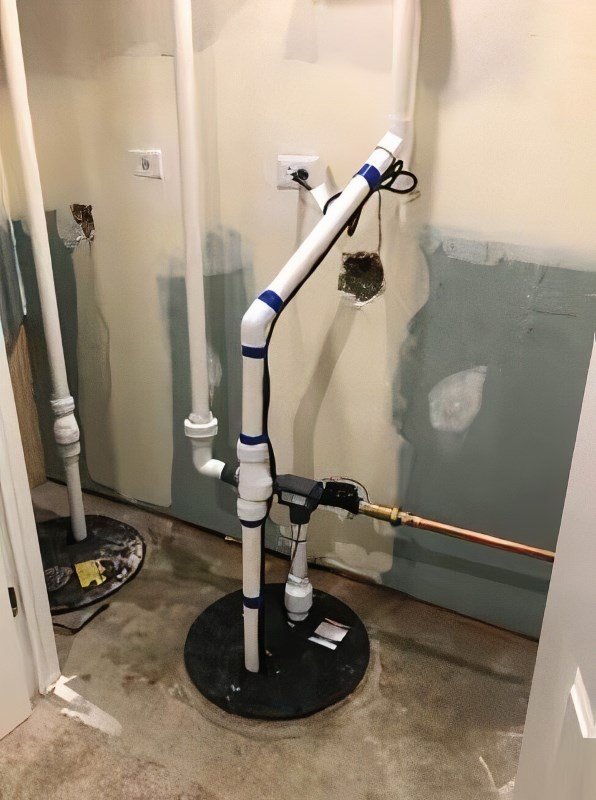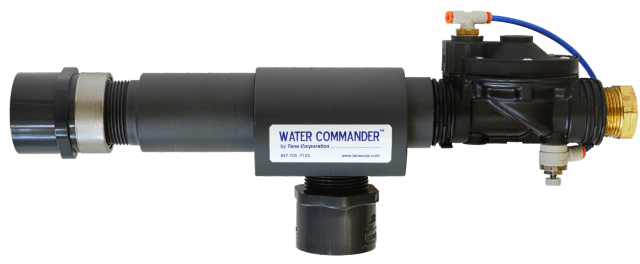While it is not uncommon for backup sump pumps to be tied into the existing discharge pipe, we recommend using an independent discharge.
When you install a emergency backup sump pump system, you have to choose between using a independent discharge pipe solely for your backup pump or tying into the preexisting discharge pipe used by your primary sump pump.

Although it is very common to use the existing discharge pipe, an independent discharge is preferred for three important reasons:
- When you tie into an existing discharge pipe, you are creating a potential path back into the sump.
- If a blockage occurs in the existing discharge pipe, this will affect both the primary pump and the emergency backup.
- During extreme rainstorms, two sump pumps discharging into one pipe can be restricting and impede pumping speed.
1. Using an existing discharge creates a potential path back into the sump.
The most important reason to not connect the discharge pipe of the backup sump pump to the existing discharge coming out of the primary electric pump, is that you are creating a potential path for the discharge water coming out of the emergency backup pump to go back into the sump. You’re not just putting the discharge into a pipe that goes up and out of the home, but also a pipe that returns to the sump pit.
People generally don’t worry about this issue because they connect the emergency discharge above a check valve installed on the existing discharge pipe they are tying into. However, over time, this check valve can fail.
There are different grades of check valves, some can withstand higher pressure than others. Every time when the emergency backup runs, you are adding water pressure that is not normally there. This can wear on a check valve, especially when the valve is relatively weak and can only withstand 25 pounds of back pressure. Many of the check valves advertised as sump pump check valves, the black rubber, hose-clamp style check valves, are only rated to 25 PSI.
Now a good check valve, like a PVC style, can withstand 75 pounds of back pressure. Yet, even then, there’s no guarantee that over the years the valve won’t fail for some reason mechanically.

The best practice is to have an independent pipe for your backup sump pump. If you have to tie into the existing discharge pipe, you want to make sure to have a good quality valve below where you tie it in. If you do decide to tie into the existing discharge pipe, you need make sure to use a higher quality check valve that is rated for higher PSI than the cheaper valves often used.
2. A blockage in the discharge pipe would render both pumps useless if an independent pipe is not used.
If there is a blockage issue with the existing discharge outside, this could render both the primary and the emergency backup pump useless. For example, there are times when the discharge pipe goes into mud, which causes a blockage. We’ve also seen times when water in the discharge pipe freezes, preventing any water from leaving the pipe. Or if the discharge pipe flows into a retention pond and that pond fills with water, you will be pumping against a lake so to speak, which also prohibits flow.
If you don’t have an independent discharge and your primary electric sump pump fails due to a pipe blockage, when the backup sump pump kicks on, it will be unsuccessfully trying to pump out the same blocked pipe. It’s best to avoid this potential problem and install a second discharge pipe to reduce the risk.
3. Two pumps discharging into one pipe can restrict water flow.
The third reason is that when both the standard electric sump pump and the emergency backup need to run simultaneously, they will be putting two pumps worth of water into only one pipe. When both pumps are trying to pump out the same pipe, this causes a bottleneck. Not nearly as much water is being pumped as could be possible if they both had separate discharge pipes.
This can happen during those 100 year storms that seem to come every couple years. It may not be a typical scenario, but it does occur and we’ve seen it many times.
Conclusion: Independent discharge is preferred.
Whenever possible, we strongly recommend using an independent discharge for your backup sump pump system. While it requires additional work and may not be as aesthetically desirable, two separate discharge pipes could save your basement from flooding.
If you decide to tie into the existing discharge, make sure to use a quality check valve that is rated to 75 PSI and also regularly check your discharge pipe to ensure it won’t be blocked during a rainstorm.
Looking for a backup sump pump?

If you are currently looking for an emergency backup system for your sump, check out Water Commander™. Water Commander is a water-powered backup sump pump that runs on your home’s municipal water pressure. Since it doesn’t use any batteries or electricity, it won’t unexpectedly lose power during a storm and will run whenever you need it to. Learn more by visiting the rest of our website. If you have any questions, please reach out to us and we’ll be happy to help you out.
Introducing Water Commander™
Water Commander™ is the best backup sump pump system available on the market today. It’s non-electric, can out-pump your electric sump pump, and will run at full power for years to come.
It is more reliable than battery backups and is the perfect solution for homes with municipal water.
Pumping Demo
Check out below a live pumping demonstration of Water Commander™ Model MG36 for homes with 1″ water lines.
Related Posts
- How To Measure Your Home’s Water Pressure
- Why Is My Sump Pump Not Working?
- How to Prevent Basement Flooding
- Battery Backup Sump Pump Troubleshooting Guide
- My Battery Backup Sump Pump Alarm Won’t Stop Beeping (Fixes)
Categories
Tag Cloud
Alarm Backup Sump Pump Batteries Basement Flooding Beeping Bernoulli Principle Best Sump Pump Check Valves Crawlspace Discharge Pipes Drain Tiles Ejector Jet Float Assembly Independent Discharge Municipal Water Perforated Sump Pits Power Outages Primary Sump Pump Failure Pros and Cons Pumping Charts Pumping Efficiency Pumping Rates Pump Life Span Pump Run Time Pump Testing Radon Gas Suction Pipe Sump Basin Sump Pump Motor Sump Pump Switch Troubleshooting Ultimate Guide Venturi Effect Water Drainage Systems Water Pressure Water Pressure Gauge Water Usage


